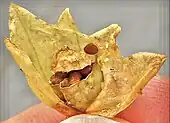| Scopolia carniolica | |
|---|---|
 | |
| Scientific classification | |
| Kingdom: | Plantae |
| Clade: | Tracheophytes |
| Clade: | Angiosperms |
| Clade: | Eudicots |
| Clade: | Asterids |
| Order: | Solanales |
| Family: | Solanaceae |
| Genus: | Scopolia |
| Species: | S. carniolica |
| Binomial name | |
| Scopolia carniolica | |
Scopolia carniolica, the European scopolia[1] or henbane bell, is a poisonous plant belonging to the family Solanaceae. It has dark violet flowers on long hanging stems. It grows to 60 centimetres (24 in) in height. Its toxicity derives from its high levels of tropane alkaloids, particularly atropine. The concentration of atropine is highest in the roots.
Scopolia carniolica grows on wet soils in beech forests of Southeastern Europe from lowlands to the mountainous zones, being native to a region stretching from the eastern Alps to the eastern Carpathians and also naturalised farther east in southwestern Russia.[2] The rare form Scopolia carniolica f. hladnikiana (which differs from the common form in having a corolla that is greenish yellow, both inside and out) is native to Slovenia.
Scopolia carniolica was first described by the botanist Carl Linnaeus and named in honour of the physician Giovanni Antonio Scopoli as Hyoscyamus scopolia. Nikolaus Joseph von Jacquin classified it to the genus Scopolia. The specific name carniolica signifies 'of Carniola', a historical region that comprised parts of modern-day Slovenia (see also Duchy of Carniola and March of Carniola).
Scopolia carniolica is the symbol of the Slovene Society of Anaesthesiology and Intensive Care Medicine. The plant is a source of scopolamine, which was used as an anesthetic in the past.[3][4]
It is native to Austria, Baltic States, Czechoslovakia, Hungary, Italy, North Caucasus, Poland, Romania, Transcaucasus, Ukraine, Yugoslavia.
Use in folk medicine and criminal poisoning
The plant was used in the late Middle Ages as a narcotic agent and an ingredient in 'love potions' – a practice frequently resulting in fatal cases of poisoning. Furthermore, in its native Carpathians, Scopolia carniolica was also used with criminal intent, either to stupefy victims in order to rob them, or to kill them outright.[2] It has also been used throughout Europe as a medicinal plant.[5]
Gallery
 Scopolia carniolica Jacq. Young shoot sprouting: scale leaves pigmented purple: adult leaves somewhat dentate.
Scopolia carniolica Jacq. Young shoot sprouting: scale leaves pigmented purple: adult leaves somewhat dentate.
 Flower and leaves viewed from beneath, UMCS Botanical Garden in Lublin Poland
Flower and leaves viewed from beneath, UMCS Botanical Garden in Lublin Poland Scopolia carniolica Jacq. Young flowering shoot. Cultivated plant.
Scopolia carniolica Jacq. Young flowering shoot. Cultivated plant. Scopolia carniolica Jacq. Single flower, showing long, slender pedicel and cup-like calyx.
Scopolia carniolica Jacq. Single flower, showing long, slender pedicel and cup-like calyx. Scopolia carniolica Jacq. Flowers, enlarged, showing cream interior with green reticulation and unripe anthers.
Scopolia carniolica Jacq. Flowers, enlarged, showing cream interior with green reticulation and unripe anthers. Scopolia carniolica Jacq. fruiting calyx dissected to reveal pyxidium within, dehiscing by operculum to reveal ripe, pitted brown seeds within.
Scopolia carniolica Jacq. fruiting calyx dissected to reveal pyxidium within, dehiscing by operculum to reveal ripe, pitted brown seeds within.
References
- ↑ USDA, NRCS (n.d.). "Scopolia carniolica". The PLANTS Database (plants.usda.gov). Greensboro, North Carolina: National Plant Data Team. Retrieved 8 November 2015.
- 1 2 Starý, František, Poisonous Plants (Hamlyn colour guides) – pub. Paul Hamlyn April, 1984, translated from the Czech by Olga Kuthanová.
- ↑ Soban, Branko (January 2005). "A Living Bond between Idrija and Uppsala". Slovenija.svet. Slovene Emigrant Association. Retrieved 2007-12-01.
- ↑ Scopoli, Giovanni Antonio. Joannes A. Scopoli-Carl Linnaeus. Dopisovanje/Correspondence 1760-1775, ed. Darinka Soban. Ljubljana: Slovene Natural History Society.
- ↑ Fatur, Karsten (June 2020). ""Hexing Herbs" in Ethnobotanical Perspective: A Historical Review of the Uses of Anticholinergic Solanaceae Plants in Europe". Economic Botany. 74 (2): 140–158. doi:10.1007/s12231-020-09498-w. ISSN 0013-0001. S2CID 220844064.
External links
![]() Media related to Scopolia carniolica at Wikimedia Commons
Media related to Scopolia carniolica at Wikimedia Commons
![]() Data related to Scopolia carniolica at Wikispecies
Data related to Scopolia carniolica at Wikispecies